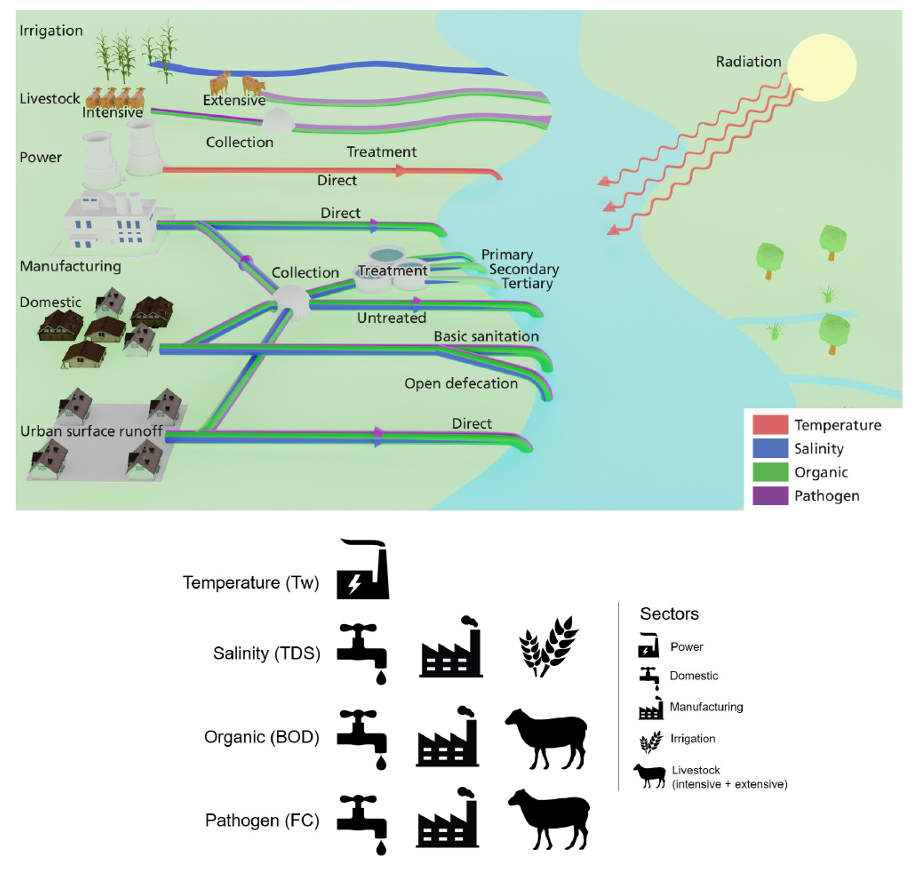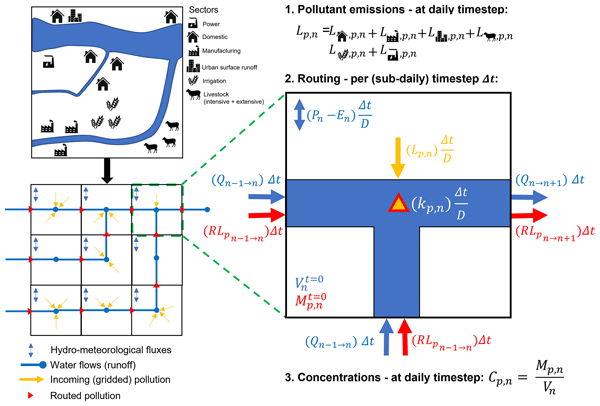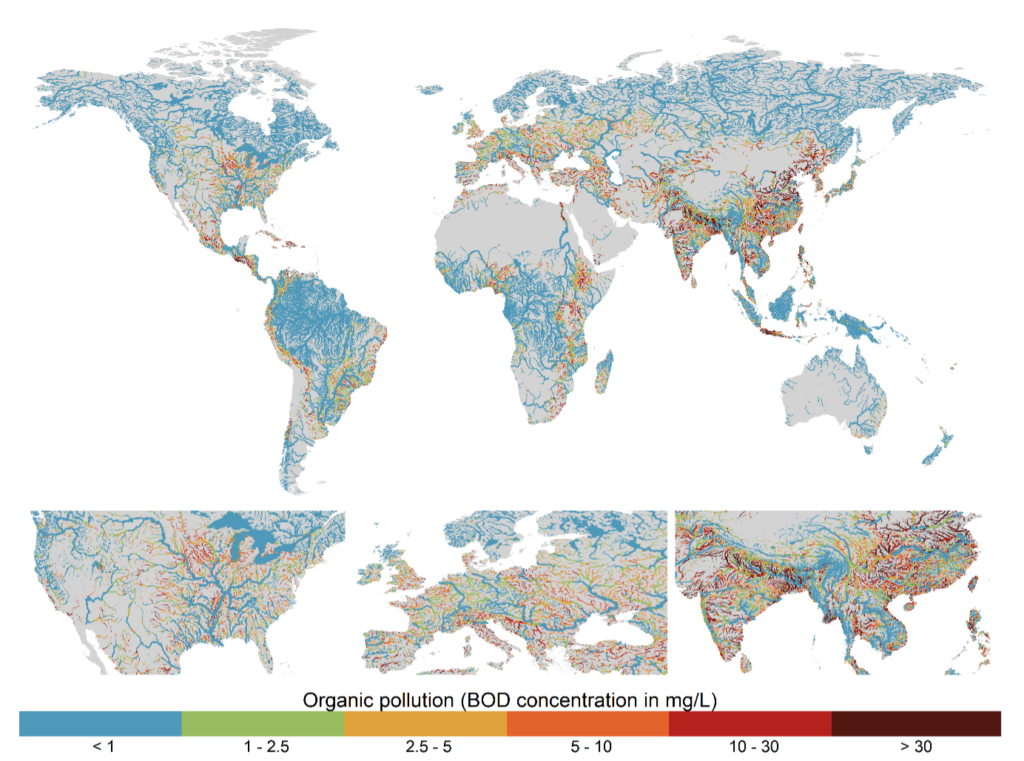DynQual surface water quality model
The Dynamical surface water Quality (DynQual) model is a grid based large-scale surface water quality model developed at the Department of Physical Geography, Utrecht University. DynQual is open source and builds upon the global hydrological model PCR-GLOBWB2 (Sutanudjaja et al., 2018) and the water temperature model DynWat (van Beek et al, 2012; Wanders et al., 2019). DynQual simulates both the pollutant emissions from different human water use activities (Figure 1) in addition to their subsequent routing through the surface water network (Figure 2), facilitating estimates of both pollutant loadings and concentrations.
DynQual v1.0 (Jones et al., 2023) has been used to simulated water temperature (Tw) and concentrations of total dissolved solids (TDS), biological oxygen demand (BOD) and fecal coliform (FC) as indicators of salinity, organic pollution and pathogen pollution, respectively, at 5 arc-minute spatial resolution and with a daily timestep. An example set-up that includes all necessary input data for running DynQual v1.0 for the Rhine-Meuse basin (~ 6GB) is available.
Water temperature is simulated by solving the surface water energy balance, and further includes the impact of heat dumps produced in thermo-electric powerplants on water temperature using the approach of van Vliet et al. (2012). TDS is modelled as a conservative substance, while BOD and FC are modelled as non-conservative substances that include first-order decay processes (Van Vliet et al., 2021).
Output from DynQual v1.0 is freely available for both past conditions (1980-2019) and under global change scenarios (2005-2100) at 5 arc-minute resolution. In addition, output aggregated to 0.5 degree resolution is available for also available for past and future conditions. An example of how this data can be visualized is displayed in Figure 3.
Please note that DynQual is still being actively developed. For the most recent updates, please refer to the code and documentation found here.

Figure 1. Sources of salinity, organic, pathogen and temperature pollution by sector and including wastewater management pathways simulated in DynQual v1.0 (Jones et al, 2022, Nat Comms E&E)

Figure 2. Schematic overview of DynQual, including a translation of the local hydrological and socio-economic situation into a local drain direction (LDD) map that includes hydrological and pollutant fluxes and a representation of the grid-cell-based processes (pollutant emission calculation, routing procedure and computation of pollutant concentrations) in an individual DynQual grid cell (Jones et al, 2023, GMD).

Figure 3. Annual average biological oxygen demand (BOD) concentrations for the period 2010–2019 plotted for rivers with >10m3 s–1annual average discharge (Jones et al, 2023, GMD).
Model description papers:
DynQual: Jones, E.R., M.F.P. Bierkens, N. Wanders, E.H. Sutanudjaja, L.P.H. van Beek and M.T.H. van Vliet (2023). DynQual v1.0: a high-resolution global surface water quality model, Geosci. Model Dev., 16, 4481–4500, https://doi.org/10.5194/gmd-16-4481-2023
PCR-GLOBWB2: Sutanudjaja, E. H., R. van Beek, N. Wanders, Y. Wada, J. H. C. Bosmans, N. Drost, R. J. van der Ent, I. E. M. de Graaf, J. M. Hoch, K. de Jong, D. Karssenberg, P. López López, S. Peßenteiner, O. Schmitz, M. W. Straatsma, E. Vannametee, D. Wisser and M.F.P. Bierkens (2018). PCR-GLOBWB 2: a 5 arcmin global hydrological and water resources model, Geosci. Model Dev., 11, 2429-2453, https://doi.org/10.5194/gmd-11-2429-2018.
DynWat: Wanders, N. M.T.H van Vliet, Y. Wada, M. F.P. Bierkens and L. P. H. van Beek, (2019). High‐resolution global water temperature modeling. Water Resources Research, 55(4), 2760-2778, https://doi.org/10.1029/2018WR023250
Model application papers:
Jones, E.R., M.F.P. Bierkens, N. Wanders, E. H. Sutanudjaja, L.P.H. van Beek, M.T.H. van Vliet (2022) Current wastewater treatment targets are insufficient to protect surface water quality, Communications Earth & Environment, 3(1), 1–8, https://doi.org/10.1038/s43247-022-00554-y
Jones, E.R., M.F.P. Bierkens, P.J.T.M. van Puijenbroek, L.P.H. van Beek, N. Wanders, E.H. Sutanudjaja, M.T.H. van Vliet (2023) Sub-Saharan Africa will increasingly become the dominant hotspot of surface water pollution, Nature Water, 1, 602–613, https://doi.org/10.1038/s44221-023-00105-5
Jones, E.R., M.F.P. Bierkens, M.T.H. van Vliet (2024) Current and future global water scarcity intensifies when accounting for surface water quality, Nature Climate Change, 14, 629–635, https://doi.org/10.1038/s41558-024-02007-0
Jones, E.R., R. van Beek, G. Cárdenas Belleza, P. Burek, S.J. Dugdale, M. Flörke, D. Fridman, S.N. Gosling, R. Kumar, D. Mercado-Bettin, H. Müller Schmied, Z. Tan, W. Thiery, A.B. Tilahun, N. Wanders, M.T.H. van Vliet (2025) A multi-model assessment of global freshwater temperature and thermoelectric power supply under climate change, Environmental Research: Water, 1(2), 025002, https://doi.org/10.1088/3033-4942/addffa
Other references used as basis for water quality concept in DynQual:
van Vliet, M.T.H., E. Jones, E., W.H.P. Franssen, M. Flörke, N. Hanasaki, Y. Wada, J.R. Yearsley (2021) Global water scarcity including surface water quality and expansions of clean water technologies, Environmental Research Letters, 16, 024020, https://doi.org/10.1088/1748-9326/abbfc3
Reder, K., Flörke, M., and Alcamo, J. (2015) Modeling historical fecal coliform loadings to large European rivers and resulting in-stream concentrations, Environ. Model. Softw., 63, 251–263, https://doi.org/10.1016/j.envsoft.2014.10.001
Contact details
Contact (DynQual): Dr. Edward R. Jones (e.r.jones@uu.nl) and Prof. Dr. Michelle T.H. van Vliet (m.t.h.vanvliet@uu.nl)
Contact (PCR-GLOBWB2): Dr. Edwin H. Sutanudjaja (E.H.Sutanudjaja@uu.nl).

